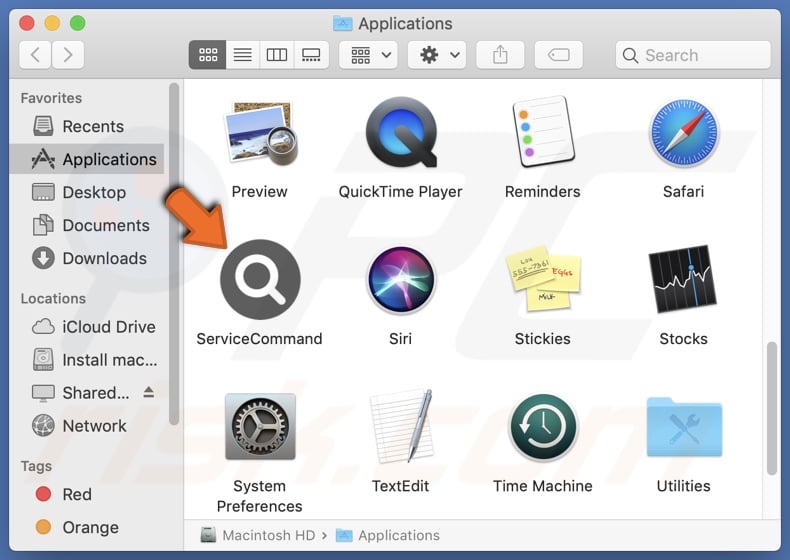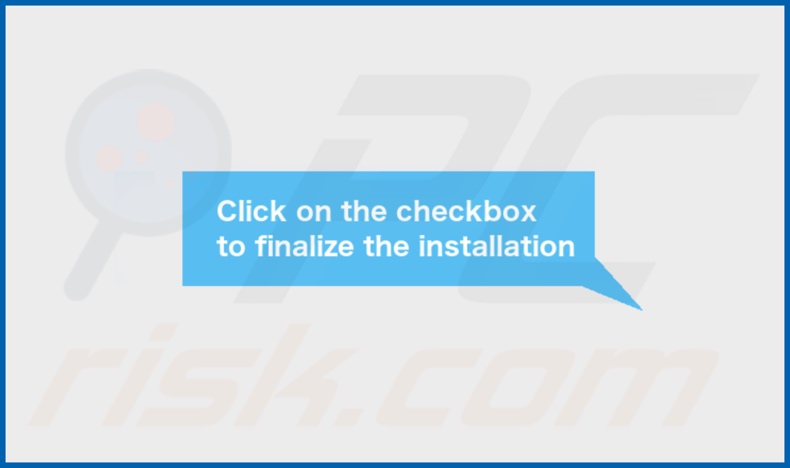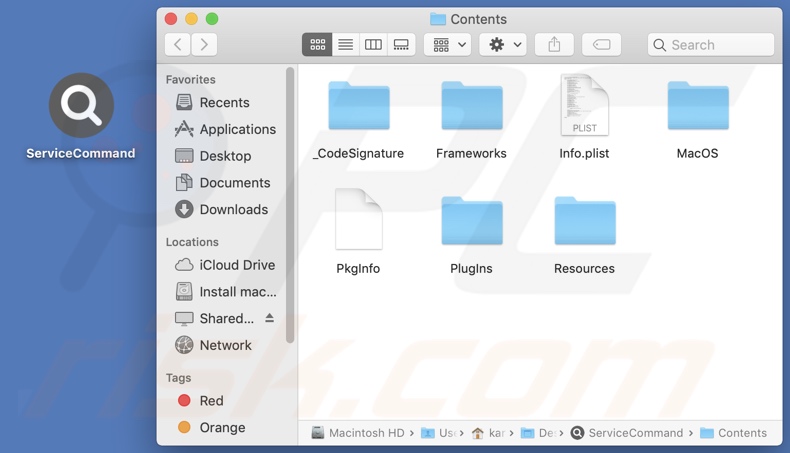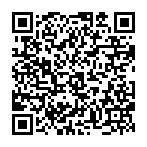How to remove ServiceCommand adware and the ads it delivers
![]() Written by Tomas Meskauskas on
Written by Tomas Meskauskas on
What kind of application is ServiceCommand?
Our researchers found the ServiceCommand application while reviewing new submissions to the VirusTotal platform. After investigating this piece of software, we determined that it is adware. ServiceCommand belongs to the AdLoad malware family. This app is designed to deliver intrusive advertisement campaigns.

ServiceCommand adware overview
Adware stands for advertising-supported software. It runs intrusive advert campaigns. This software displays advertisements on visited webpages and/or other interfaces.
The delivered third-party graphical content (e.g., pop-ups, banners, overlays, coupons, etc.) mainly endorses online scams, untrustworthy/dangerous software, and even malware. When clicked on, some of the ads can execute scripts to perform stealthy downloads/installations.
Note that any genuine products/services encountered via these adverts are most likely promoted by scammers abusing their affiliate programs in order to obtain illegitimate commissions.
Advertising-supported software may require certain conditions to deliver intrusive ad campaigns, e.g., compatible browser/system, visits to specific websites, and so on. However, regardless of whether ServiceCommand displays advertisements – its presence on a system remains a threat to device/user safety.
Furthermore, AdLoad applications often have browser-hijacking functionalities, but we did not observe these qualities while analyzing ServiceCommand.
What is more, adware typically has data-tracking functionalities, and this might apply to the ServiceCommand app. Information of interest may include: browsing and search engine histories, Internet cookies, log-in credentials, personally identifiable details, credit card numbers, etc. The collected data can then be shared with and/or sold to third-parties.
In summary, the presence of software like ServiceCommand on devices can lead to system infections, serious privacy issues, financial losses, and even identity theft.
| Name | Ads by ServiceCommand |
| Threat Type | Adware, Mac malware, Mac virus |
| Detection Names | Avast (MacOS:Adload-AG [Adw]), Combo Cleaner (Gen:Variant.Adware.MAC.AdLoad.13), ESET-NOD32 (A Variant Of OSX/Adware.Synataeb.G), Kaspersky (Not-a-virus:HEUR:AdWare.OSX.Adload.h), Full List (VirusTotal) |
| Additional Information | This application belongs to Adload malware family. |
| Symptoms | Your Mac becomes slower than normal, you see unwanted pop-up ads, you are redirected to dubious websites. |
| Distribution methods | Deceptive pop-up ads, free software installers (bundling), torrent file downloads. |
| Damage | Internet browser tracking (potential privacy issues), display of unwanted ads, redirects to dubious websites, loss of private information. |
| Malware Removal (Mac) | To eliminate possible malware infections, scan your Mac with legitimate antivirus software. Our security researchers recommend using Combo Cleaner. |
Adware examples
We have examined numerous adware samples; ProgressFunction, RenewingImprove, and CyberSpaceLogin are just a couple of our newest finds. While advertising-supported software appears legitimate and offers various functionalities, it seldom operates as promised. The features serve as bait that tricks users into downloading/installing the software.
It must be stressed that regardless of whether an application or a browser extension operates as indicated by its promotional material – that does not guarantee either legitimacy or safety.
How did ServiceCommand install on my computer?
Adware can be bundled with ordinary programs. The risk of allowing bundled content into the device is increased by downloading from dubious channels (e.g., freeware and free file-hosting sites, P2P sharing networks, etc.) and by rushing through installation processes (e.g., skipping steps, using "Quick/Easy" settings, etc.).
Adware can also have "official" promotional pages, and it is endorsed on scam websites. The majority of users access these webpages via redirects generated by sites using rogue advertising networks, mistyped URLs, spam browser notifications, intrusive ads, or installed adware (with browser force-opening capabilities).
Additionally, advertising-supported software is spread by intrusive adverts. Once clicked on, some of these advertisements can execute scripts to perform downloads/installations without user permission.
How to avoid installation of adware?
We highly recommend researching software and downloading it only from official/trustworthy sources. When installing, it is important to read terms, study available options, use the "Custom/Advanced" settings, and opt out of all supplements (e.g., apps, extensions, features, etc.).
We advise being vigilant while browsing since fraudulent and malicious online content usually appears genuine and innocuous. For example, intrusive ads may look harmless – yet redirect to highly questionable websites (e.g., scam-promoting, pornography, adult dating, gambling, etc.).
If you keep encountering adverts and/or redirects of this kind, check the device and immediately remove all suspect applications and browser extensions/plug-ins. If your computer is already infected with ServiceCommand, we recommend running a scan with Combo Cleaner Antivirus for macOS to automatically eliminate this adware.
Pop-up window displayed once ServiceCommand adware's installation is over:

ServiceCommand adware's installation folder:

Instant automatic Mac malware removal:
Manual threat removal might be a lengthy and complicated process that requires advanced IT skills. Combo Cleaner is a professional automatic malware removal tool that is recommended to get rid of Mac malware. Download it by clicking the button below:
▼ DOWNLOAD Combo Cleaner for Mac
By downloading any software listed on this website you agree to our Privacy Policy and Terms of Use. To use full-featured product, you have to purchase a license for Combo Cleaner. Limited seven days free trial available. Combo Cleaner is owned and operated by Rcs Lt, the parent company of PCRisk.com read more.
Quick menu:
- What is ServiceCommand?
- STEP 1. Remove ServiceCommand related files and folders from OSX.
- STEP 2. Remove ServiceCommand ads from Safari.
- STEP 3. Remove ServiceCommand adware from Google Chrome.
- STEP 4. Remove ServiceCommand ads from Mozilla Firefox.
Video showing how to remove ServiceCommand adware using Combo Cleaner:
ServiceCommand adware removal:
Remove ServiceCommand-related potentially unwanted applications from your "Applications" folder:

Click the Finder icon. In the Finder window, select "Applications". In the applications folder, look for "MPlayerX","NicePlayer", or other suspicious applications and drag them to the Trash.
After removing the potentially unwanted application(s) that cause online ads, scan your Mac for any remaining unwanted components.
Remove adware-related files and folders

Click the Finder icon, from the menu bar. Choose Go, and click Go to Folder...
 Check for adware generated files in the /Library/LaunchAgents/ folder:
Check for adware generated files in the /Library/LaunchAgents/ folder:

In the Go to Folder... bar, type: /Library/LaunchAgents/

In the "LaunchAgents" folder, look for any recently-added suspicious files and move them to the Trash. Examples of files generated by adware - "installmac.AppRemoval.plist", "myppes.download.plist", "mykotlerino.ltvbit.plist", "kuklorest.update.plist", etc. Adware commonly installs several files with the exact same string.
 Check for adware generated files in the ~/Library/Application Support/ folder:
Check for adware generated files in the ~/Library/Application Support/ folder:

In the Go to Folder... bar, type: ~/Library/Application Support/

In the "Application Support" folder, look for any recently-added suspicious folders. For example, "MplayerX" or "NicePlayer", and move these folders to the Trash.
 Check for adware generated files in the ~/Library/LaunchAgents/ folder:
Check for adware generated files in the ~/Library/LaunchAgents/ folder:

In the Go to Folder... bar, type: ~/Library/LaunchAgents/

In the "LaunchAgents" folder, look for any recently-added suspicious files and move them to the Trash. Examples of files generated by adware - "installmac.AppRemoval.plist", "myppes.download.plist", "mykotlerino.ltvbit.plist", "kuklorest.update.plist", etc. Adware commonly installs several files with the exact same string.
 Check for adware generated files in the /Library/LaunchDaemons/ folder:
Check for adware generated files in the /Library/LaunchDaemons/ folder:

In the "Go to Folder..." bar, type: /Library/LaunchDaemons/

In the "LaunchDaemons" folder, look for recently-added suspicious files. For example "com.aoudad.net-preferences.plist", "com.myppes.net-preferences.plist", "com.kuklorest.net-preferences.plist", "com.avickUpd.plist", etc., and move them to the Trash.
 Scan your Mac with Combo Cleaner:
Scan your Mac with Combo Cleaner:
If you have followed all the steps correctly, your Mac should be clean of infections. To ensure your system is not infected, run a scan with Combo Cleaner Antivirus. Download it HERE. After downloading the file, double click combocleaner.dmg installer. In the opened window, drag and drop the Combo Cleaner icon on top of the Applications icon. Now open your launchpad and click on the Combo Cleaner icon. Wait until Combo Cleaner updates its virus definition database and click the "Start Combo Scan" button.

Combo Cleaner will scan your Mac for malware infections. If the antivirus scan displays "no threats found" - this means that you can continue with the removal guide; otherwise, it's recommended to remove any found infections before continuing.

After removing files and folders generated by the adware, continue to remove rogue extensions from your Internet browsers.
Remove malicious extensions from Internet browsers
 Remove malicious Safari extensions:
Remove malicious Safari extensions:

Open the Safari browser, from the menu bar, select "Safari" and click "Preferences...".

In the preferences window, select "Extensions" and look for any recently-installed suspicious extensions. When located, click the "Uninstall" button next to it/them. Note that you can safely uninstall all extensions from your Safari browser - none are crucial for regular browser operation.
- If you continue to have problems with browser redirects and unwanted advertisements - Reset Safari.
 Remove malicious extensions from Google Chrome:
Remove malicious extensions from Google Chrome:

Click the Chrome menu icon ![]() (at the top right corner of Google Chrome), select "More Tools" and click "Extensions". Locate all recently-installed suspicious extensions, select these entries and click "Remove".
(at the top right corner of Google Chrome), select "More Tools" and click "Extensions". Locate all recently-installed suspicious extensions, select these entries and click "Remove".

- If you continue to have problems with browser redirects and unwanted advertisements - Reset Google Chrome.
 Remove malicious extensions from Mozilla Firefox:
Remove malicious extensions from Mozilla Firefox:

Click the Firefox menu ![]() (at the top right corner of the main window) and select "Add-ons and themes". Click "Extensions", in the opened window locate all recently-installed suspicious extensions, click on the three dots and then click "Remove".
(at the top right corner of the main window) and select "Add-ons and themes". Click "Extensions", in the opened window locate all recently-installed suspicious extensions, click on the three dots and then click "Remove".

- If you continue to have problems with browser redirects and unwanted advertisements - Reset Mozilla Firefox.
Frequently Asked Questions (FAQ)
What harm can adware cause?
Adware can decrease browsing quality and system performance. It displays advertisements that endorse content capable of causing system infections, privacy issues, financial losses, and other serious problems. Advertising-supported software typically has data-tracking abilities – therefore, it is considered to be a threat to user privacy.
What does adware do?
Adware is designed to run intrusive advertisement campaigns. Primary functions can include displaying ads on visited websites and/or different interfaces, generating redirects, and gathering sensitive information.
How do adware developers generate revenue?
Most of the profit is made through affiliate programs by promoting content. Adware developers may earn commissions from ad clicks, website visits, file downloads, product purchases, service subscriptions, or similar.
Will Combo Cleaner remove ServiceCommand adware?
Yes, Combo Cleaner can scan devices and eliminate installed adware-type applications. It is pertinent to mention that manual removal (unaided by security programs) might not be a perfect solution. In some cases, file leftovers remain hidden within the system after the adware has been manually removed. What is more, these components might continue to run and cause issues. Hence, it is paramount to eliminate advertising-supported software thoroughly.


▼ Show Discussion